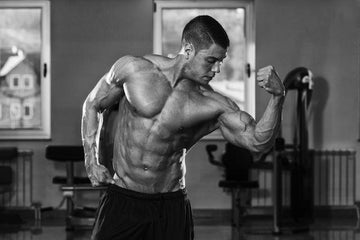

The Olympian Body-Shock Program for Muscle Strength Gains
Table of Contents
The Olympian Body-Shock Program for Muscle Strength Gains
by: Robbie Durand
Most bodybuilders follow the same workout day in and day out. They have a routine that they have been using for years, and it has not changed at all. Many people think they can just follow the routine of Arnold Schwarzenegger or Ronnie Coleman, and they will get slabs of muscle like these Olympians. The fact of the matter is that you should train like all of them!! Based on the newest research, you need a combination of heavy and light weights to make the best gains. What I mean by this is one day you should train heavy like Dorian Yates while one day you should rep it out like Lee Haney. Contrary to old belief that to get bigger and stronger, you must lift heavy lifting every day, just does not apply to the advanced lifter. If this were the case, you would get stronger and stronger each workout, which clearly does not happen and many lifters reach a plateau. Trying to lift heavy every day will only lead to overtraining and a workout plateau. The key to breaking a plateau is to use different sets and reps each workout. Previous research has shown that the manipulation of volume and intensity is the most important factor to produce strength improvements. Accordingly, the lifter will combine all the different training regimens in a week’s working combing hypertrophy training (8-12 reps), strength training (4-8 reps) and power training (1-3 reps).
 Here is a sample of some of the former Olympians Workout:
Here is a sample of some of the former Olympians Workout:
Dorian Yates Back Workout
3 set of hammer strength pull downs of 15-30 reps
2 sets of barbell rows of 8-20 reps
1 set of hammer strength one-arm row of 10 reps
1 set of cable rows with overhand grip of 10 reps
1 set of hammer strength rear-delt machine of 10 reps
1 set of bent over dumbbell raises of 10 reps
1 set of hyperextensions of 10-12 reps
2 sets of deadlifts of 8-12 reps
Lee Haney Chest Workout
• Bench Press – 4 sets of 6-8 reps
• Dumbbell Bench Press – 3 sets of 8-10 reps
• Incline Bench Press – 4 sets of 6-8 reps
• Incline Dumbbell Bench Press – 3 sets of 8-10 reps
Arnold Arm Workout
• Superset one: Barbell curls superset with lying triceps extensions
• 4 sets of 10 to 12 reps for each superset (combination of two exercises) without rest, or at the very least, minimal rest
• Superset two: Alternate dumbbell curls superset with pushdowns (either variety)
4 sets of 10 to 12 reps for each superset
• Superset three: Seated incline curls superset with kneeling extensions
4 sets of 10 to 12 reps for each superset
• Superset four: Concentration curls superset with one-arm triceps extensions
4 sets of 10 to 12 reps for each superset
• Bench Dips – 2 sets of 26 reps
Ronnie Coleman Leg Workout
6 Sets of Squats of 12
4 Sets of Leg presses of 12 reps
2 Sets of parking lot lunges(100 yards)
3 Sets of Stiff leg Deadlifts of 12 reps
3 Sets of Seated leg Curls of 10-12 reps
Phil Heath Delts Workout
• 2 warm-up sets of 10 to 15 reps with moderate weight
• 2 sets of 8-12 reps or until failure, 60 seconds rest
• 2 drop sets of 4 to 6 reps or until failure
Machine Side Lateral Raise- 3 sets of 10 to 12 reps or until failure, 30 seconds rest
Bent Bar Front Delt Raises -3 sets of 10 to 12 reps or until failure, 30 seconds rest
Plate Loaded Military Press-5 sets of 10 to 12 reps or until failure, 30 seconds rest
Shock Your Body into New Growth
Most bodybuilders train with block periodization is which their training cycle is divided into several phases with a unique goal and a duration of 6-8 weeks. For example, in the offseason, most lifters train heavy and bulk up, and as they transition to competition, they train lighter as calories are cut back. The first block or phase of the resistance training program is usually focused on muscle hypertrophy in the offseason, whereas the subsequent stages are dedicated to higher repetitions as the competition season approaches.
So should a bodybuilder train in blocks or should they try a weekly undulating periodization routine in which they combine all cycles in a week. This means every day you walk into the gym, your doing a different workout. A previous study by Professor Kraemer found that periodized multiple-set resistance training protocols consisting of various sets and reps were superior to heavyweight, few reps, single-set resistance training to enhance maximal strength, fat-free mass, and serve velocity in competitive collegiate players. This was the first study to open up the possibility that including multiple regimens of strength, power, and hypertrophy rep ranges is superior to just training with heavy weights with five repetitions. Researchers wanted to examine a weekly undulating training routine to a block periodization routine and examine muscle strength and muscle mass gains.
Following this study, another research group found that improvements in lower-body strength were significantly greater in the when the subject’s rotated their set and reps (+27.7%) compared with the specialized workloads lasting 2-4 weeks group (+15.2%). Both groups significantly increased arm muscle hypertrophy whereas improvements in thigh muscle size were significant in the weekly changing workout model group only. The weekly workout changes showed greater increases in lower-body muscle area by an average of 5.8% compared with an average of 1.6% in the block periodization group. Results of this study indicate that the weekly workout changes model is more effective than the block periodization model for increasing maximal strength and muscle size in the lower body. So if you’re looking to maximize gains, a lifter should be incorporating a broad range of resistance exercise variable and changing sets, repetitions, and training volume.
40% Greater Strength Gains with Daily Changes in Your Workout
Researchers wanted to test the ultimate training program to determine which was the best for putting on strength in experienced resistance training subjects. Horizontal leg press, chest press, butterfly, lat pull-down, horizontal row, dumbbell shoulder press, cable triceps push-downs, and dumbbell biceps curls – all done on standard gym equipment.
The following loading schemes were randomly matched to each sample:
-a.)constant load with constant volume of repetitions,
-b.) increasing load with decreasing volume of repetitions,
-c.)decreasing load with increasing volume of repetitions,
-d.) daily changing load and volume of repetitions.
The total number of repetitions was identical between all the workouts. To isolate the variables of interest (i.e., intensity and volume), both within-set and between-set rest was standardized between samples. All the subject’s gained strength from the training protocol, but guess what protocol reigned supreme? In all cases, daily changing load obtained significantly higher strength gains than the other programs. There were no significant differences between constant load, increasing load, and decreasing load. The findings of the study indicate that resistance training following daily changing load is more effective for advanced recreational athletes constant load, increasing load, or decreasing load workout. This type of training is not the norm for bodybuilding, but the research was quoted as saying, “Considering that daily changing load and volume of repetitions is widely unknown in fitness-related resistance training, the present data indicates, there is a potential for improving resistance training in commercial fitness clubs.” The researchers suspected that the greater increases in muscle strength from changing your workout was due to greater neural adaptions during daily changing workouts are a result of the constant change in motor unit recruitment. The largest fluctuation in motor unit recruitment may lead to the exhaustion of more and different units.
Key Points: Changing your workout on a daily basis can lead to greater increases in muscle strength and possibly muscle mass.
MUSCLE MEDIA MAGAZINE FOR MEN
The premier source of training, nutrition, supplements, fat loss and health for men.
Eifler C. Short-Term Effects of Different Loading Schemes in Fitness-Related Resistance Training. J Strength Cond Res. 2016 Jul;30(7):1880-9.
Bartolomei S, Stout JR, Fukuda DH, Hoffman JR, Merni F. Block vs. Weekly Undulating Periodized Resistance Training Programs in Women. J Strength Cond Res. 2015 Oct;29(10):2679-87.
Kraemer, WJ, Ratamess, N, Fry, AC, Triplet McBride, T, Koziris, LP, Bauer, JA, Lynch, JM, and Fleck, SJ. Influence of resistance training volume and periodization on physiological and performance adaptations in collegiate women tennis players. Am J Sports Med 28:626–708, 2000.
Hartman, H, Bob, A, Wirth, K, and Schmidtbleicher, D. Effect of different periodization models on rate of force development and power ability of upper extremities. J Strength Cond Res 23: 1921–1932, 2009.
Hoffman, JR, Wendell, M, Cooper, J, and Kang, J. Comparison between linear and nonlinear in-season training program in freshman football players. J Strength Cond Res 17: 561–565, 2003.
Issurin, VB. New horizons for the methodology and physiology of training periodization. Sports Med 40: 189–206, 2010.
Merni, F, Bartolomei, S, and Ciacci, S. Periodization of strength training: From traditional to daily undulating periodization. Medicina Dello Sport 67: 513–526, 2014
Stone MH, Potteiger JA, Pierce KC, Proulx CM, O’Bryant HS, Johnson RL, Stone ME. Comparison of the effects of three different weight-training programs on the one repetition maximum squat. J Strength Cond Res 14: 332–337, 2000.
Monteiro AG, Aoki MS, Evangelista AL, Alveno DA, Monteiro GA, Piçarro IC, Ugrinowitsch C. Nonlinear periodization maximizes strength gains in split resistance training routines. J Strength Cond Res 23: 1321–1326, 2009.

















